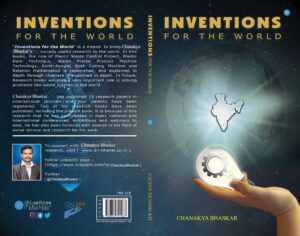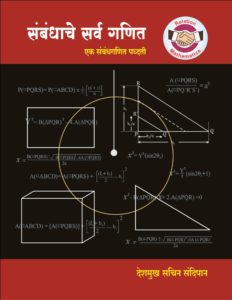
Welcome to our page dedicated to books on plastic waste management and recycling solutions. Here, we present the book “Inventions for the World,” authored by Chanakya Bhaskar. This book is a culmination of extensive and diverse research endeavors. The research addresses pressing global challenges, with a primary focus on plastic pollution and its impact on the environment. It delves into innovative solutions like the Plastic Dam Technique and Waste Plastic Product Machine (WPPM) technology. Furthermore, it seamlessly integrates mathematical research into these initiatives, particularly in the realm of “Relational Mathematics,” with the goal of making this innovative concept accessible to a broader audience. This book is not just a book but a compendium of transformative potential.
Book Details: “Inventions for the World”
“Here are the specific details for the book “Inventions for the World,” by Chanakya Bhaskar:”
Author’s Name: Chanakya Bhaskar
Title’s Name: Inventions for the World
ISBN: 978-93-5668-418-8
Book size: 5×8 inches
Paperback MRP: Rs.325
Binding: Paperback
Lamination on Cover: Matte
Orientation: Portrait
Text Pages/Page count: 256
Cover Paper: 230 GSM C1S
Language: English
Audience: Adult, Children, General
Text Color: Black and White
Text Paper/Paper quality: Natural Shade 60 GSM

About the Author: Chanakya Bhaskar
“Chanakya Bhaskar has been dedicatedly advancing research, ideas, and concepts through his book “Inventions for the World.” Concurrently, he serves in a governmental capacity, contributing to national service. This remarkable journey commenced in 2008, resulting in four registered patents and the publication of ten research papers in esteemed international journals. A notable accomplishment includes the composition of “The Great Method of Relation All Mathematics,” a Marathi publication that explores “Relation Mathematics.””
“Central to his work is addressing the escalating issue of plastic pollution, both in India and worldwide. He has pursued two key research avenues: Plastic Dam and Waste Plastic Product Machine (WPPM) Technology. The Plastic Dam innovation showcases a transformative solution that impacts plastic pollution, water conservation, and empowerment, without causing air, water, or land contamination. The WPPM technology aims to convert plastic waste into useful products through innovative processing methods. This technology adapts to available resources and contributes significantly to plastic waste management.”
“Chanakya has embarked on an extensive exploration of “Relation Mathematics,” aligning this research with the Plastic Waste Control Project (PWCP). This research initiative has yielded eight research papers published in renowned international journals. It is accompanied by the publication of “The Great Method of Relation All Mathematics” in Marathi, which was released on December 22, 2015. The primary objective is to popularize social mathematics across diverse demographics and age groups.”
“The book also expounds upon additional research concepts. For instance, it asserts that “The Earth is not round in shape; it assumes the form of an Earth-angle.” Furthermore, the “Bush Cutting Machine” concept finds elucidation within these pages. With unwavering confidence, Chanakya anticipates these research endeavors will serve as a guiding light for substantial future accomplishments.”
About the Book: “Inventions for the World”
“Chanakya Bhaskar presents the book “Inventions for the World”, a repository of comprehensive research for the global populace. The book encompasses a range of significant research areas. This notably includes the Plastic Dam Technique, Waste Plastic Product Machine (WPPM) technology, and Relational Mathematics. In the book, Chanakya extends his heartfelt gratitude to the invaluable supporters who were instrumental in its culmination.”
“The initial five chapters of the book are dedicated to resolving the pervasive issue of plastic pollution on a global scale. They present compelling solutions to this pressing challenge. Chanakya has seamlessly integrated mathematical research with his initiatives in plastic waste management. The cornerstone of this endeavor is a Marathi publication titled “Sambhadhache Sarva Ganit, Ek Sambhandha Ganit Paddhati,” which was released on December 22, 2015. Additionally, eight research papers from this work have been published in esteemed international journals. Subsequent chapters span mechanical and astronomical explorations, delving into the
“Bush Cutting Machine” and challenging conventional notions about Earth’s shape.” “The author’s ongoing engagement with diverse research topics underscores a relentless pursuit of knowledge. The book is a compendium of rigorous research. Its narrative promises to usher in a transformative impact, particularly in combatting the pressing challenge of plastic pollution. Furthermore, it promises to illuminate unexplored horizons of knowledge. The writer is confident that this scholarly endeavor will catalyze an unparalleled revolution on the global stage. This book serves as a conduit for ongoing research efforts, with subsequent editions reflecting future advancements.”
Key Points about “Inventions for the World” and Author Chanakya Bhaskar
“Here are the key points about the book “Inventions for the World,” and its author, Chanakya Bhaskar:”
i. Comprehensive Research: The book is a culmination of extensive and diverse research endeavors spanning several significant fields.
ii. Global Relevance: The research addresses pressing global challenges, with a primary focus on plastic pollution and its impact on the environment.
iii. Plastic Pollution Solutions: The initial chapters of the book delve into innovative solutions, such as the Plastic Dam Technique and Waste Plastic Product Machine (WPPM) technology. These solutions are aimed at combating plastic pollution and conserving resources.
iv. Mathematical Innovations: Chanakya Bhaskar seamlessly integrates mathematical research into his initiatives. This is particularly in the realm of “Relational Mathematics,” with the goal of making this innovative concept accessible to a broader audience.
v. Publication and Recognition: The author’s Marathi book, “Sambhadhache Sarva Ganit, Ek Sambhandha Ganit Paddhati,” was released on December 22, 2015. This book serves as a cornerstone. Additionally, eight research papers derived from this work have garnered recognition through publication in esteemed international journals.
vi. Multidisciplinary Exploration: Beyond plastic pollution, the book covers a spectrum of subjects. This includes mechanical and astronomical research. It also challenges conventional notions about Earth’s shape and introduces concepts like the “Bush Cutting Machine”.
vii. Research Dissemination: The author actively seeks to disseminate research through various channels. This encompasses media, conferences, exhibitions, and interactions with VIPs. The goal is to create widespread awareness and impact.
viii. Scholarly Impact: Chanakya Bhaskar’s dedication to research extends beyond writing. His work exemplifies a researcher’s spirit, which is evident in the depth and breadth of his exploration.
ix. Transformative Potential: “Inventions for the World” is not just a book but a compendium of transformative potential. It is poised to contribute significantly to global issues like
x. plastic pollution while fostering new realms of knowledge.
xi. Continuous Evolution: The book represents an ongoing journey. Subsequent editions will adapt to evolving research, reflecting the author’s commitment to continuous advancement.
xii. Gratitude and Acknowledgment: Chanakya Bhaskar expresses gratitude to supporters and well-wishers who played an instrumental role in the realization and dissemination of the book’s research.
xiii. Revolutionary Vision: The author’s visionary perspective anticipates a groundbreaking revolution sparked by the impact of “Inventions for the World”.
xiv. Global Significance: The book’s comprehensive research and innovative insights are poised to influence and guide research initiatives worldwide.

“I aim to introduce the subject of “Relation Mathematics” to a global audience. This emerging field offers innovative perspectives in the realm of mathematics. Its cornerstone is the seminal work titled “The Great Method of Relation All Mathematics,” which I authored. This book, written in Marathi, marks a significant milestone in the field of Relation Mathematics.”
“The book was unveiled on December 22, 2015. This date coincided with India’s National Mathematics Day. Since its unveiling, it has garnered international attention. Eight research papers I authored have been published in esteemed international journals. This further cements the significance of this new discipline.”
““Relation Mathematics” presents a unique opportunity for researchers, scholars, and enthusiasts. It allows them to delve into uncharted territories within the mathematical landscape. This subject encompasses a range of interconnected mathematical relationships. These relationships have the potential to reshape our understanding of various mathematical phenomena. By fostering exploration, “Relation Mathematics” paves the way for groundbreaking discoveries. Its application extends beyond traditional mathematical paradigms. In essence, the subject offers a gateway to a new realm of mathematical exploration.”
About Relation Mathematics
“I have introduced a new subject in mathematics called “Relation Mathematics”. I also published the first book titled “The Great Method of Relation All Mathematics”. Additionally, I have authored eight research papers in international journals. The book was released on December 22, 2015. This date is India’s National Mathematics Day. The book was published in the Marathi language. Overall, Relation Mathematics offers a promising avenue for exploring novel mathematical concepts.”
Published book - Relation All Mathematics
Email Id- relationmathematics@dri-bharat.co.in
“The first book on the subject of ‘Relation Mathematics’ is titled ‘The Great Method of the Relation All Mathematics.’ This comprehensive book introduces numerous relations, concepts, and theorems. Any future research connected to ‘Relation All Mathematics’ will inherently incorporate the essential elements of the ‘Relation Mathematics’ subject.”
“The Great Method of the Relation All Mathematics” has been published online in the Marathi language. You can access it through the provided link: http://www.readwhere.com/publication/9916/Relation-All-Mathematics-
Relation All Mathematics

Research Inside “Relation All Mathematics” Book
“The book “Relation All Mathematics” contains comprehensive research. It introduces a variety of new concepts and methodologies:”
Chapter number 1 introduces the methodology of fundamental concepts.
Formulas elucidate the relationship between squares, rectangles, and two rectangles.
The connection between two right-angled triangles is established through formulae. This is accompanied by a proof of the Pythagoras theorem within the framework of “Relation All Mathematics.”
Within a right-angled triangle, the square of the hypotenuse is equated to the difference between the squares of the side measurements (b1+h1) and four times the area.
A novel quadratic equation formula is derived. This formula relates to both rectangles and right-angled triangles. Notably, this formula is derived independently of the contemporary quadratic equation.
The relationship between cuboids and cubes is defined using pertinent formulas.
The practical application of the cuboid-cube relationship in the agricultural industry is explored.
The Pythagoras theorem is rigorously proven using the “Relation All Mathematics” approach in Topic no. 6.
Utilizing the relationship between two right-angled triangles, the interplay of hypotenuse, base, height, side measurements, and area is expounded. This is particularly under conditions of equal area and equal side measurements.
“Relation All Mathematics” constitutes an emerging field. It introduces a spectrum of relationships through this research. Future studies related to this work inherently contribute to the advancement of the subject of “Relation Mathematics.”
[Note: The research has been ongoing since 2007 and continues to evolve.]


